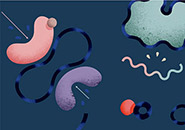
Scientific Discipline
Genetics, Molecular Biology
Related Links
Host Institution
Massachusetts General Hospital
Current Position
Dr. Lee is also a professor of genetics and pathology at Harvard Medical School and a molecular biologist at Massachusetts General Hospital, Boston.
Current Research
Epigenetic Regulation by Long Noncoding RNA
Research
Biography
In 1991, as an MD/PhD student at the University of Pennsylvania, Jeannie Lee was studying Fragile X syndrome, a developmental disorder caused by a gene mutation on the X chromosome. That's when she learned of a phenomenon that would shape the rest of her career.
Researchers had just discovered an RNA molecule that glommed on to one of the two X chromosomes in female cells. In mammals, only one X chromosome is active in each cell: The second is shut down to prevent overproduction of the proteins its genes encode. The newly discovered RNA, named Xist, was found coating inactivated X chromosomes. Scientists speculated enthusiastically that Xist might be responsible for shutting down the X chromosome.
Especially fascinating to Lee was the idea that this RNA may not be a passive genetic messenger, but may instead be exerting powerful control over gene activity. "When I first heard the Xist story, I knew that I wanted to work with this noncoding RNA," she recalls.
Lee delved into the details of X chromosome inactivation, first as a postdoctoral researcher in the lab of Rudolf Jaenisch at the Massachusetts Institute of Technology, then in her own lab at Massachusetts General Hospital. In Jaenisch's lab, Lee inserted the Xist gene into mouse cells on an autosomal chromosome—neither X nor Y—and found that it could trigger inactivation there.
As an independent investigator, she found that Xist works with a crew of other RNAs and proteins to designate and shut down an inactive X chromosome. She also found Xist's antisense counterpart, Tsix RNA, and showed that Tsix protects the active X chromosome from silencing by Xist. Later, she discovered that another noncoding RNA, Jpx, is responsible for activating Xist by knocking a repressor protein off of the gene. "The X inactivation center is full of noncoding RNAs," she says.
As Lee unraveled the mechanisms of X inactivation, long noncoding RNA—previously unrecognized and even dismissed by many scientists— moved into the molecular biology spotlight. In the first decade of the new millenium, researchers uncovered more and more examples of RNA molecules that boost or inhibit the activity of specific genes. Today, biologists suspect human cells might produce more than 200,000 different RNAs that are never translated into proteins. "There is the distinct possibility that a good fraction of them will end up being controlling elements," Lee says. "RNAs may be front and center when it comes to controlling gene expression."
Understanding that control has become the central quest in Lee's research. She's still studying X chromosome inactivation, because it's a great system for illuminating gene regulation strategies that may be in use elsewhere in the genome. "A lot of things can be understood through the lens of X chromosome inactivation," she says.
In 2008, Lee's team found that Xist RNA recruits a protein called Polycomb Repressor Complex 2 (PRC2) to the X chromosome. PRC2 was already known to shut down a number of genes throughout the genome, but scientists had puzzled over how the protein found its targets. "We showed that PRC2 is inherently capable of interacting with RNA. Not just with Xist, actually, but with thousands of other RNAs," Lee says.
In fact, Lee's team identified more than 9,000 RNAs that bind to PRC2. "That gave us the idea that we can leverage the noncoding RNAs to treat disease," she says. Lee's team devised a method to turn up the activity of specific genes—even those whose protein products have been considered "undruggable" with other targeted therapies— by blocking a noncoding RNA's interaction with PRC2. That boosts activity of the RNA's target gene by freeing it from the repressor. "We turned this into a therapeutic platform to turn up genes that are deemed desirable," Lee says.
Lee has recently turned her focus back to the interest that launched her career: X-linked disease. She'd like to use her knowledge of X chromosome inactivation to develop potential treatments for patients with diseases like Fragile X and Rett Syndrome, where a functional copy of the disease-causing gene is usually present, but silenced because it is on the inactive X chromosome. "I'd like to figure out a way to reactivate a normal copy of the gene," Lee says. "The inactive X is pretty well locked up, but we will find a way!"
Articles & News
Research Papers
Selected Research Papers




